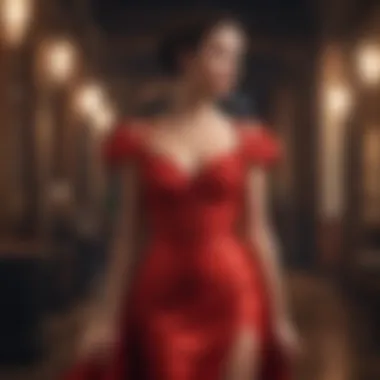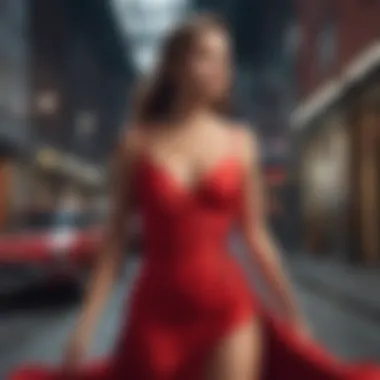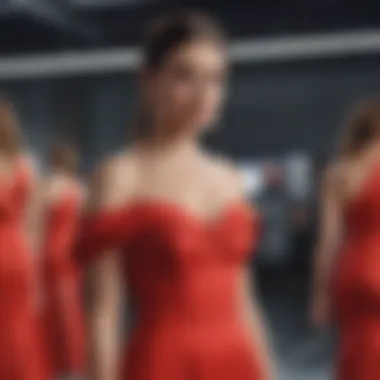Exploring the Red Dress: Symbolism and Impact in Fashion


Intro
The red dress holds a unique position in the lexicon of fashion marketing. Its vibrant hue is not just a color; it serves as a symbol of passion, power, and desire. Over the years, brands have leveraged the allure of the red dress to create memorable marketing campaigns that resonate deeply with consumers. This article aims to unravel the complexities and significance of this iconic garment in the world of promotional strategy.
Understanding the red dress requires a keen insight into its historical context. Fashion has been influenced by cultural shifts, and the red dress is no exception. From early depictions in art to contemporary runway shows, its significance has evolved, but its impact remains unchanged. As consumers navigate their identity through clothing, the red dress stands out as a beacon of self-expression and individuality.
In this exploration, we will dissect various promotional strategies employed by brands, examining how they tap into psychological principles to evoke emotions and drive consumer behavior. By considering case studies, we aim to highlight successful red dress promotions that have captured attention and sales.
Furthermore, we will delve into the role of social media, which has transformed how brands communicate and market their products. With the rise of platforms like Instagram and TikTok, the visual appeal of the red dress can be effectively showcased, reaching audiences far and wide.
The aim of this article is to provide a deeper understanding of the red dress phenomenon, discussing how it transcends mere fashion. By analyzing its symbolism and marketing applications, we seek to offer valuable insights for both marketers and consumers alike.
Intro to the Red Dress Phenomenon
The red dress holds a significant position in both fashion and marketing. Its power and appeal are undeniable, making it an essential focal point for brands aiming to connect with consumers. Understanding the allure of the red dress goes beyond superficial aesthetics. It involves a complex interplay of cultural meaning, historical context, and psychological impact that collectively shape consumer behavior.
When we explore the red dress phenomenon, we consider how it can serve as a tool of empowerment. This garment often symbolizes confidence and boldness, attributes that resonate with many women. For marketers, harnessing this symbolism effectively can enhance brand identity and foster deeper connections with their target audience.
In this article, we will analyze various aspects of the red dress, including its definition in fashion, its historical roots, cultural symbolism, and its psychological effects. We will also investigate how brands utilize these elements in promotional strategies and the emerging trends surrounding the red dress in today's fashion landscape.
Through this exploration, we aim to provide insights into not just why the red dress captivates, but also how it plays a pivotal role in shaping consumer interactions and preferences within the fashion market.
Cultural Symbolism of the Red Dress
The red dress carries a significant weight in cultural contexts, often representing more than just a fashion choice. It is imbued with meanings that vary across different societies and historical periods. This section explores the multifaceted cultural symbolism associated with the red dress, examining how its color and design affect perceptions and associations.
The Color Red: Meaning and Associations
Red is a color that cannot be easily ignored. It evokes strong emotions and has a rich palette of meanings. In many cultures, red signifies passion, love, and desire. For instance, during romantic occasions, red is predominantly used to symbolize deep affection. It commands attention and can invoke a sense of urgency or excitement.
Furthermore, red is often associated with power and authority. Various cultures have used red as a representation of status. This duality of emotion and power makes the red dress a compelling choice in fashion marketing. Brands leverage this color to create marketing strategies that resonate with their audiences on an emotional level.
- Passion and Love: Often worn on romantic dates or special occasions.
- Power and Authority: Frequently used in corporate and formal clothing.
- Energy: Invokes an immediate response, urging action or excitement.
These associations make the red dress not just a garment but a statement, often seen as both an intimate and powerful piece of clothing.
The Red Dress Across Different Cultures


The red dress serves distinct cultural meanings around the world. In China, for example, the color red signifies good luck and prosperity. It is customary for brides to wear red during their wedding ceremonies, symbolizing joy and a successful union. Contrarily, in South Africa, red is worn during mourning, showcasing a stark contrast in the uses of this color.
In Western countries, the symbolism takes on a different dimension. The red dress often embodies sexual allure and confidence. From cinema to haute couture, it is often depicted as a daring choice for women who are unafraid to showcase their presence. The association with empowerment and femininity is prevalent in marketing campaigns that feature iconic red dresses.
"The red dress resonates across cultures, representing a tapestry of meanings that reflect societal values and norms."
Here are some notable cultural contexts of the red dress:
- China: Good luck and marital bliss.
- South Africa: Mourning and remembrance.
- Western Cultures: Confidence, seduction, and empowerment.
Psychological Impact of the Red Dress
The psychological impact of the red dress is significant in understanding its role within fashion marketing and consumer behavior. This section will explore how the red dress influences perceptions, garners attention, and elicits emotional responses. The nuances of these psychological factors are essential for brands aiming to leverage the unique appeal of the red dress. Recognizing these effects allows marketers to create more targeted and effective promotional strategies.
Influence on Perception and Attention
Color psychology indicates that certain colors can evoke various feelings and reactions. Red is often associated with passion, desire, and strength. When a consumer sees a red dress, it commands immediate attention. Brands can benefit greatly from this reaction. The red dress acts like a beacon, pulling in the observer's gaze and making it hard to dismiss. Marketing studies show that bright colors, especially red, can increase visibility and memorability, critical elements in promotional campaigns.
Moreover, when individuals wear a red dress, they may be perceived as more attractive. This perception is not simply subjective; it has a basis in psychological research. Studies reveal that red can enhance one's attractiveness and increase the likelihood of social engagement. Thus, when brands use red dresses in their advertisements, they efficiently harness this psychological advantage, influencing the way consumers view not just the product but also themselves when wearing it.
Emotional Responses Triggered by Red
The color red can trigger a spectrum of emotional responses. Research indicates that red can provoke feelings of excitement and urgency, both beneficial in prompting consumer action. When consumers see a red dress, they may feel a surge of energy or an inclination to act, whether that means to purchase, share, or simply admire.
Conversely, the emotional responses can vary depending on personal experiences and cultural factors. In some contexts, the red dress symbolizes love and celebration, while in others, it might denote danger or caution. These dualities add rich layers to the way consumers interact with the red dress in different settings.
By leveraging the emotional impact of red, brands can structure messages that resonate deeply with their target audience. The red dress thus becomes more than an item of clothing; it becomes a catalyst for emotional connection between the consumer, the garment, and the brand itself.
"The red dress transcends mere fashion; it becomes a dialogue between identity and emotion."
Promotional Strategies Featuring the Red Dress
Promotional strategies play a crucial role in showcasing the red dress as a staple in fashion marketing. The red dress does not just signify style; it embodies confidence and power. In marketing, employing this iconic garment can enhance brand identity and consumer connection.
By leveraging the allure of the red dress, brands can capture attention effectively. Red piques interest. This color draws the eye and influences emotions. When brands use red dresses in campaigns, they often tap into deeper cultural contexts that resonate with consumers. Additionally, the red dress can evoke curiosity, making it an excellent choice for promotional events, advertisements, and social media posts.
Moreover, brands should consider the audience's emotional connection to the red dress. Understanding how different demographics relate to this garment can lead to more targeted marketing strategies. The key is to create campaigns that not only display the dress but also tell a story. Highlighting aspects like personal empowerment or celebrating special moments can enhance the promotional message.


Case Studies of Iconic Red Dress Campaigns
Many campaigns effectively utilized the red dress to create unforgettable marketing moments. One standout example is the advertising for the Carolina Herrera Spring-Summer collection. The boldness of the red dress, seen in their ads, captured the essence of elegance and tradition.
Another important case is the collaboration between David Yurman and Kerry Washington. The actress wore a striking red dress in their ads, which highlighted both the jewelry and her gown. This combination led to a significant increase in engagement across social media platforms.
These studies illustrate how the red dress can create a visual impact that resonates with consumers emotionally. The strength of the red dress lies in its ability to stay relevant while also embracing contemporary themes.
The Role of Influencers in Red Dress Promotions
Influencers have reshaped how brands promote the red dress. Their platforms provide a vast reach, especially among younger demographics. When influencers wear red dresses, they often curate their content to showcase personal style and storytelling, which enhances relatability. A striking example of this is the partnership between Zara and various fashion influencers who create looks centering around red dresses. These collaborations often lead to increased sales and heightened brand visibility.
Furthermore, influencers can effectively communicate brand values through their authentic content. This is important as today's consumers often seek genuine endorsements rather than traditional advertisements. Many influencers express their personal affinity for the red dress, thus connecting emotionally with their audience. This can help invoke a desire to purchase similar items from the brand.
The rise of influencer marketing in the fashion sector indicates that brands must adapt their strategies. The red dress serves as a versatile piece that caters to trends, making it easier for influencers to integrate into their wardrobe.
"The strategic use of red dresses in campaigns can significantly enhance brand identity and consumer trust."
Social Media and the Red Dress
The relationship between social media and the red dress phenomenon is profound. Social media platforms serve as powerful tools that amplify fashion trends. These platforms not only showcase the red dress but also facilitate discussion, drive engagement, and influence consumer behavior. As more users share their experiences in red dresses, the garment gains visibility and relevance. This visibility is crucial in a market where consumers are inundated with choices.
Moreover, the immediacy of social media allows brands to test the waters for new designs and concepts. The red dress is often highlighted in marketing campaigns, making it easier for consumers to associate it with various emotions and contexts which can make it more appealing.
Platforms Driving Red Dress Trends
Several key platforms have emerged as influencers in the promotion and popularity of the red dress.
- Instagram: This visually driven platform allows users to showcase their outfits effortlessly. Influencers and brands utilize Instagram to display stunning images of the red dress. This creates a visual culture that directly impacts viewers. Hashtags such as #RedDress or #FashionInRed are commonly used, making content discoverable.
- Pinterest: Users frequently search for outfit ideas on this platform. The red dress often appears as a centerpiece in numerous boards featuring looks for different occasions. This inspiration can lead to increased consumer interest in purchasing a red dress.
- TikTok: This platform has quickly become a trendsetter, especially for younger audiences. TikTok challenges often involve the red dress, showcasing its versatility and appeal. Dance trends or style challenges can turn a simple dress into a viral sensation.
While each of these platforms has its own unique style of content presentation, they all contribute significantly to the growing allure of the red dress. It is not only about the visuals; it is also about the community built around sharing and engaging with fashion.
User-Generated Content and the Red Dress
User-generated content has become a vital component in fashion marketing, particularly with the red dress. Customers now share their personal experiences and interpretations of this iconic garment across various social media platforms. This form of content is authentic and relatable, resonating more with audiences compared to traditional advertising.
Here are some of the benefits of user-generated content:


- Trust and Authenticity: When real customers post about their experiences, it builds trust with potential buyers.
- Diverse Representations: User-generated posts often highlight how different individuals style the red dress in unique ways, promoting inclusivity.
- Engagement: Brands that encourage sharing often see higher levels of engagement. Contest or hashtag campaigns can stimulate users to participate, enriching community interaction.
"The power of user-generated content lies in its ability to connect people to brands in a genuine manner."
Emerging Trends in Red Dress Fashion
The red dress stands as an icon within the fashion industry. Recent developments show it evolving not just in style, but in its role within societal contexts. This section delves into the emerging trends influencing red dress fashion today. These trends underscore critical elements like sustainability and diversity. Both elements will shape how consumers perceive and engage with this enduring garment. Understanding these trends can offer brands strategic advantages in the highly competitive fashion market.
Sustainable Fashion and the Red Dress
Sustainability has taken center stage in fashion discussions. The red dress is not excluded from this dialogue. As consumers become more Eco-conscious, the pressure on brands to adopt sustainable practices increases. Various designers are now introducing red dresses made from organic fabrics and recycled materials. For instance, brands like Reformation utilize eco-friendly production methods. This shift aligns with the growing demand for transparency in the fashion supply chain.
"Sustainable fashion is more than a trend; it's a necessity for our planet's future."
Wearers of the red dress often seek to express individuality and style. Incorporating sustainability into the equation allows them to feel good about their choices. By choosing a red dress that is ethically made, consumers contribute to a larger movement towards responsible fashion. This connection enhances the emotional investment in the garment.
Diversity and Inclusion in Red Dress Marketing
Diversity is becoming a hallmark of effective marketing strategies. As the market diversifies, the representation of different body types, skin tones, and cultural backgrounds in red dress campaigns becomes crucial. Marketing campaigns that feature diverse models in red dresses can resonate deeply with broader audiences. Brands like Savage X Fenty highlight inclusivity by showcasing various styles and sizes.
This consideration reflects a shift towards embracing the beauty of uniqueness in all forms. A well-executed campaign not only represents diversity but also creates a sense of belonging among consumers.
Inclusion in marketing leads to broader engagement and fosters brand loyalty. Consumers are more inclined to support brands they relate to and see themselves represented in. As the landscape continues to evolve, it becomes imperative for brands to adapt their marketing strategies to reflect diversity in their red dress promotions.
By embracing sustainability and diversity, the narrative surrounding the red dress can expand. It becomes a symbol not only of style but also of choice, responsibility, and inclusiveness. This progression will undoubtedly shape the future of red dress fashion, creating opportunities for brands to connect meaningfully with contemporary consumers.
Ending: The Enduring Appeal of the Red Dress
The red dress stands as a significant element in the fashion industry. This remarkable garment does more than simply adorn the wearer; it acts as a beacon of cultural and emotional resonance. Understanding its enduring appeal is essential. It not only influences personal expression but also affects marketing strategies and consumer behavior. The connection between the red dress and identity is profound, highlighting how clothing can transcend mere aesthetics to embody deeper meanings.
Future Perspectives on Red Dress Promotions
Looking ahead, the promotional landscape for the red dress will likely evolve significantly. Brands are expected to adopt more sustainable practices, appealing to environmentally-conscious consumers. The movement towards sustainable fashion is gaining momentum, and this could embed itself into marketing strategies involving the red dress.
Moreover, diversity and inclusion will play crucial roles. As the fashion industry grows more aware of representation, red dress campaigns are likely to reflect varied backgrounds and body types. This approach could enhance the garment's resonance with a larger audience. By showcasing this diversity, brands can foster a sense of belonging among consumers who may have felt marginalized in traditional marketing.
Additionally, the interplay between technology and social media will continue to reshape promotional strategies. Engaging consumers through interactive platforms can enhance their connection with the red dress. For instance, augmented reality applications could allow shoppers to visualize how the dress looks on them before making a purchase. This innovative approach can improve consumer confidence, leading to higher conversion rates.
In summary, the red dress will maintain its allure by adapting to changing consumer values and technological advancements. Styles may shift, but its cultural significance will endure. Companies that recognize these trends and respond adequately will not only secure their place in the market but also enrich the cultural narrative surrounding this iconic garment.
Important Note: Embracing sustainability and inclusion is not just a trend; it is a necessary evolution in the fashion industry.
The lasting appeal of the red dress lies not only in its beauty but also in its ability to convey emotion and identity. By integrating these emerging trends into their promotion strategies, brands can nurture a richer connection with consumers.







